Abstract
The article deals with the problem of road congestion during peak hours in Krasnoyarsk. Drivers stand in traffic jams for a long time to get to work or return home. This problem affects both the psychological part of the population of the city, and the ecological one. The city has big environmental problems, especially in winter, when carbon is poorly volatilized. Also, in the city every evening they diagnose large traffic jams on different streets. Studying and solving the problem of traffic congestion can improve the situation of the city. The development and construction of bypass roads is not always possible and does not always give a positive effect. With the help of Anylogic simulation software, possible to design models before making changes and after, based on the result, make further decisions. To optimize the phases of traffic lights, a built-in optimizer is used and is configured depending on the changing parameters of the model. The paper proposes the modernization of intersections, with the creation of separate drives, where are cars will wait for their turn to turn left and not impede the main movement straight ahead. This modernization of intersections does not require large time and economic costs.
Keywords: Optimization traffic lenght, modernization, traffic jams, crossroads
Introduction
In the world every year it is becoming more and more difficult to solve problems with transport problems in megacities due to the ever-increasing car traffic. In correlation with how the population of countries increases, so does the load on the roadbed of various cities.
In Europe, it is convenient if there is a distance of 20 km between cities and residents of one region do not live in large clusters in one city, but distribute the transport load of cities on country roads. In large cities, roads were designed more than 30 years ago, created for areas that were formed with a different number of city residents. Currently, these areas can no longer create the necessary throughput of highways roads. Large arteries of roads become congested due to the construction of houses around them, which gives rise to a large number of junctions.
The city does not always have funds for the organization of district traffic, at the same time, the construction of new district highways or interchanges takes time. During the time the interchange is being built, it will no longer provide the capacity calculated 5 years ago, including during the work, residents will encounter with a new traffic jam. Setting up a network of traffic lights also requires development and is not always effective, once the optimized phases of traffic lights will find their limit and the throughput value will stop increasing.
Transferring urban residents to public transport is also not always effective. To do this, it is necessary to develop travel routes, organize privileges and amenities for passengers, which also takes time and coordination with local residents. As a similar option Ikidid et al. (2021), this is the improvement of existing intersections or the creation of a network of underground tunnels or aboveground roads, which is also costly and not effective for every territory.
Small adjustments to intersections with minimal implementation costs can help solve the problem.
Problem Statement
The article considers the decision to reorganize the problematic section of the road in the city of Krasnoyarsk, where is traffic congestion accumulates. Traffic jams are usually organized when a large amount of car traffic comes the city streets. In different cities, in the mornings and evenings, chaotic traffic of cars is crowned for several hours and many transport hubs become overloaded. The paper considers a section of the road between two rings, 3.6 kilometres long, on which there are 2 lanes in each direction. Due to the fact that residential areas are adjacent to the road section, cars need to turn towards residential buildings. Closing left turns for cars turning left against traffic and letting all traffic turn around in circles will be time-consuming for drivers. At the moment, the traffic is organized in such a way that in order to turn, you need to take the left lane and wait for the traffic light to turn. This problem slows down the left lane due to the long wait for cars to turn and the main stream, which moves straight ahead for longer, needs to slow down and change lanes, which in turn slows it down.
Research Questions
Based on the described situation, the following questions were posed for solution:
- How to reorganize traffic at intersections so as not to slow down traffic?
- How to adjust traffic light phases?
- Check the performance of solutions over a long period of time.
Purpose of the Study
Develop a method for upgrading the roadway and a system for optimizing the phases of traffic lights on a problematic section of the road, which will increase the throughput on the studied section of the road.
Research Methods
To study the problem situation, a transport model is created in the Anylogic program version higher than 7.3, where road design and optimization studies are available Kuzmin and Baginova (2022). The model is created with model time in minutes so that you can examine the results of the models in a few hours.
Model building
The section of the road of Karaulnaya Street in the interval from the Bryanskaya ring to the ring of 9 May street is being investigated. Screenshots of this section of the road were taken from online maps and superimposed on the model palette. The pictures are overlaid with a road network that corresponds to the one that is currently functioning. Traffic lights are installed at the intersections of Karaulnaya - Chernyshevsky and Karaulnaya - Lineynaya, where cars turn to residential areas. The scale of the model is identical to that taken from the map. All roads adjacent to the studied are numbered and cars move between them. The developed model is shown in Figures 1,2,3,4.
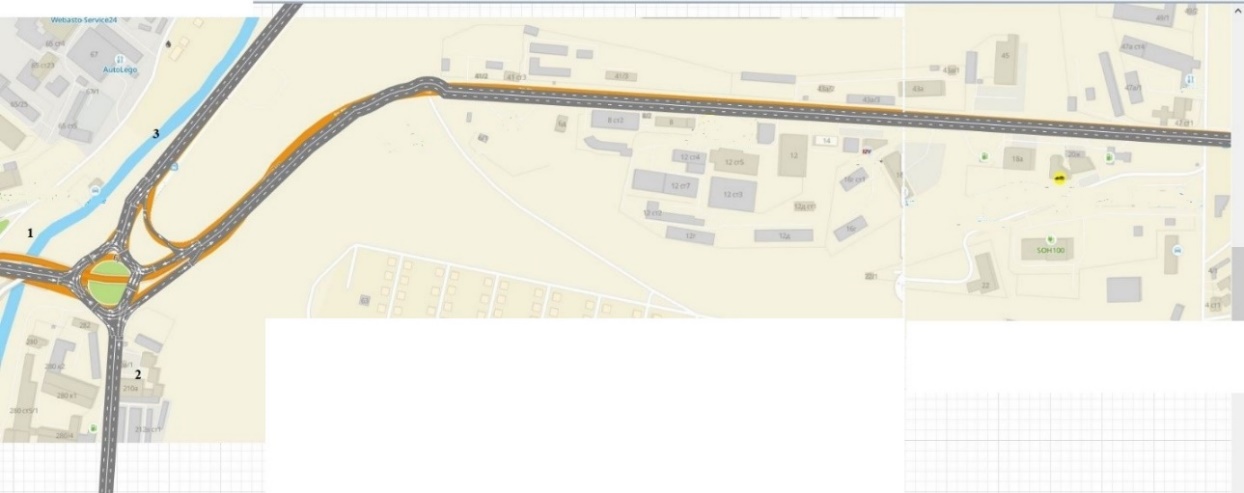
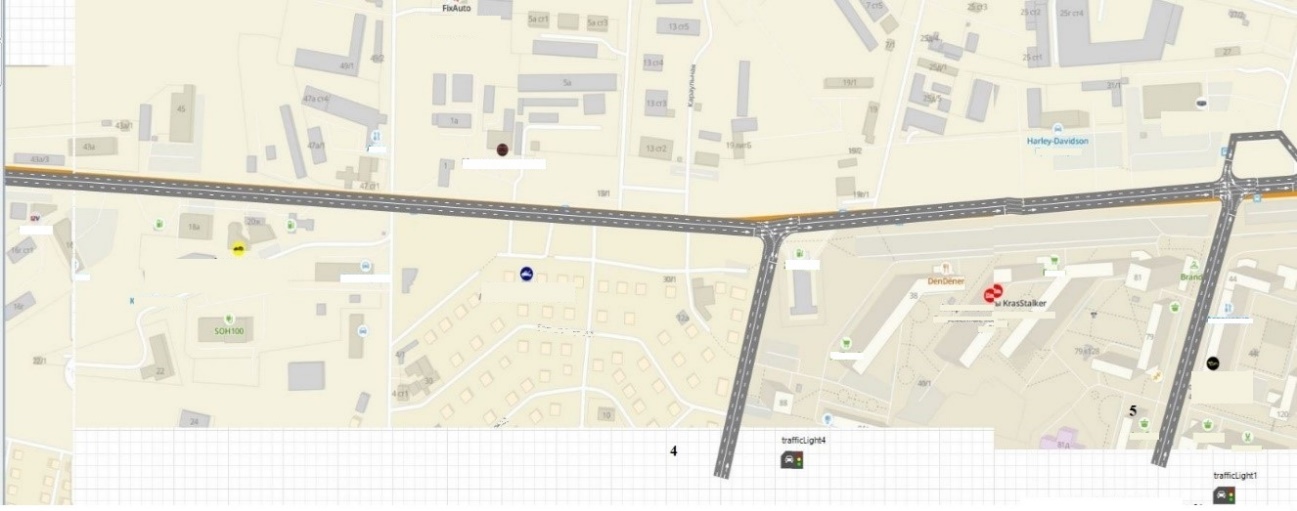
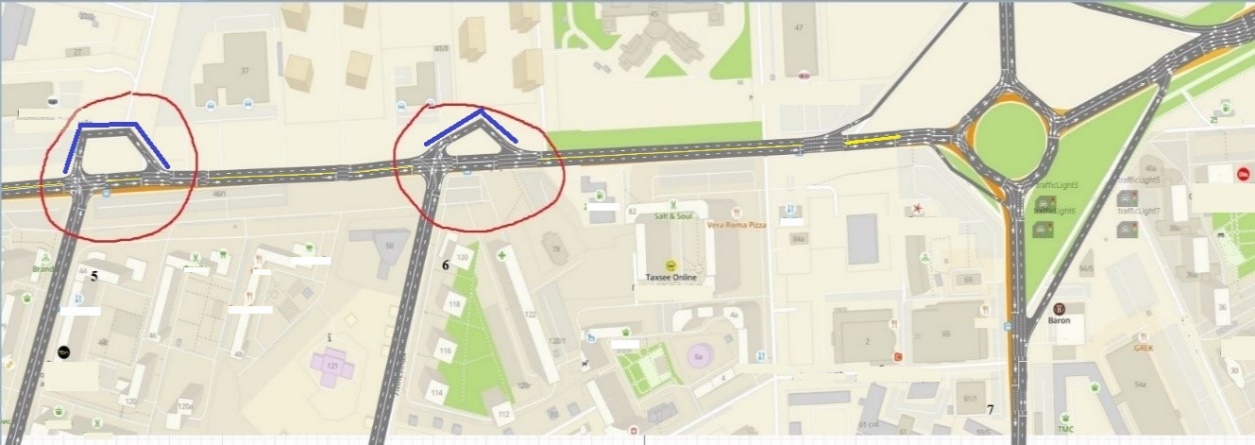
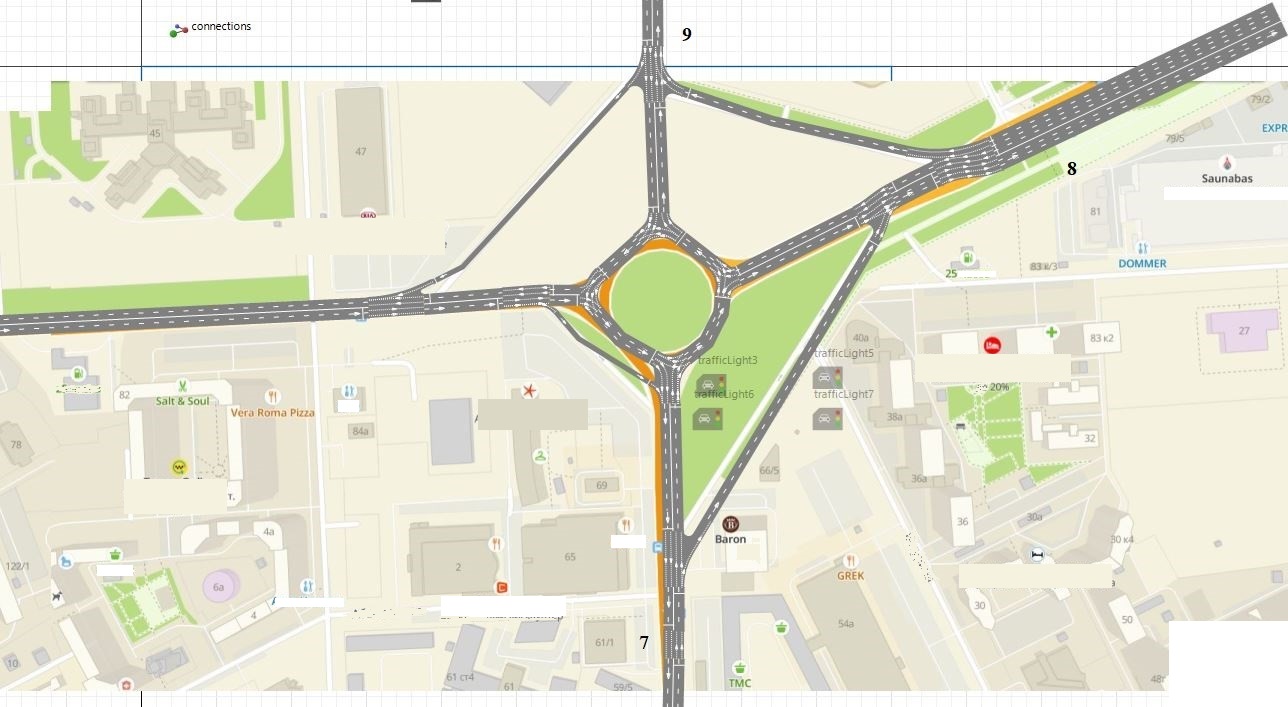
In order not to overload the work with pictures, the model immediately presents the intersections with the proposed additions (highlighted in blue). Merkuryeva and Bolshakovs (2010) crossroads marked with red circles are T-shaped. From the yellow road, cars turn onto perpendicular roads and by waiting at traffic lights, the traffic capacity of the road is reduced. Therefore, it is proposed to make branches near the road, which can be arranged since there is an area next to the road that is not busy. Branches will act as accumulators for cars that are waiting for their turn to turn and, in turn, do not impede movement along the main road in the future direction of traffic. Such a reorganization of the intersection should not require high economic investments.
Optimization method
According to Pop (2020):
Anylogic also has the ability to optimize the system created. You can optimize the system according to the specified parameters (for example, a traffic light) if you want to put the traffic light on the ring and check its effectiveness, which will be checked and minimized or maximized according to requirements. (p. 43)
Chu et al. (2015) in their study wrote:
The maximization of the system pass (number of cars) in an hour from all directions was checked. A variable was created that collected all the values of cars that had already left the system and the greater the given value, the higher the throughput of the system. Traffic light parameters are detected depending on the step between iterations. (pp. 244-245)
According to Aramesh and Ghorbanian (2020) “if there is a low value after the iteration, it is possible that your system is full of cars and cannot pass more than Sun et al. (2018) N number of cars along a given road” (p. 795).
As Song et al. (2020) wrote in their study:
The OptQuest optimizer with various analytical algorithms is built into the program. The study also helps optimize flows after changes in traffic organization, which makes it possible to know whether the innovation will work at the road junction or not. (p. 121)
The paper proposes the following method for optimizing the phase parameters of traffic lights (Lu et al., 2022):
- By maximizing the cars that passed through the model in the time studied.
Stupin et al. developing the ideas of Chen et al. (2021) stated:
That the cars maximization method collects in a dynamic variable an indicator (v) when the car left the system and the higher this indicator, the higher the throughput of the system. To achieve the result of optimizing the variable phases of traffic lights, it is necessary to maximize the objective function with respect to the parameter v. (Stupin et al., 2022, p. 1109)
The following results will be compared:
- Without upgrading the intersection and without optimizing traffic lights per hour.
- Without modernization of intersections and after optimization in an hour.
- After modernization of intersections and after optimization in an hour.
- After modernization of intersections and after optimization in 2 hours.
Research of the behaviour of models and optimization
For the convenience of comparing passing cars between roads within the system, when leaving the system, the car is recorded in the drive, which is numbered from the road of the beginning of its movement to its final destination.
In all the models studied, the cars are created as follows:
- From the streets adjacent to the houses (4,5,6) up to 150 per hour per hour to the main streets.
- From the main streets (1,2,3,7,8,9) up to 500 per hour to various streets with a probability of 20%.
The results of the unchanged model, without optimization and turns, are shown in Figure 5. Traffic light phases for the next 60 seconds for driving straight along Karaulnaya, 20 seconds for turning on to perpendicular streets, at the same time, cars turn right from the adjacent road. And 20 seconds to exit from the adjacent street to the main one.
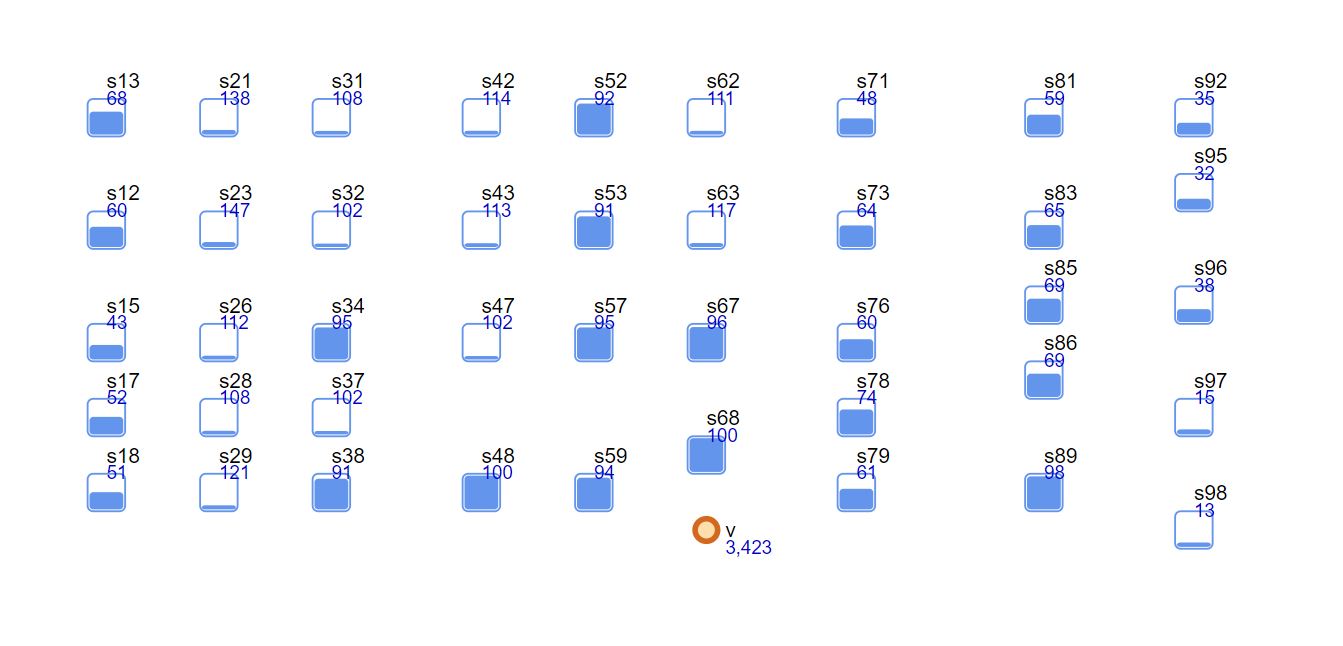
Next, the phases of two traffic lights are optimized, at the intersections highlighted in red, without their modernization. p- the main signal is green at the 5th road; p1- turn from the main street to 5 and turn from 5 to the main right; p2 - turn from the adjacent road 5 to the left and right to the main street; p3 - the main signal is green at the 6th road; p4- turn from the main street to 6 and turn from 6 to the main right; p5- turn from adjacent road 6 to the left and right to the main street. Phases are optimized to maximize passing cars per hour. The phases of traffic lights p and p3 vary from 40 to 70 seconds with a step of 5. The phases of traffic lights p1, p2, p4, p5 from 10 to 30 seconds with a step of 5. Based on the results obtained, the following result can be observed, presented in Figures 6 and 7.
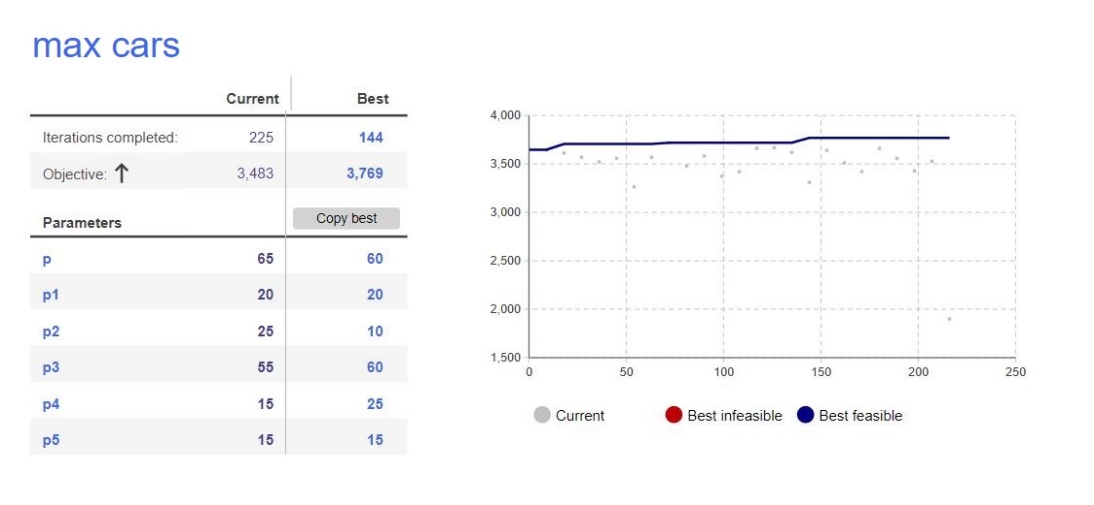
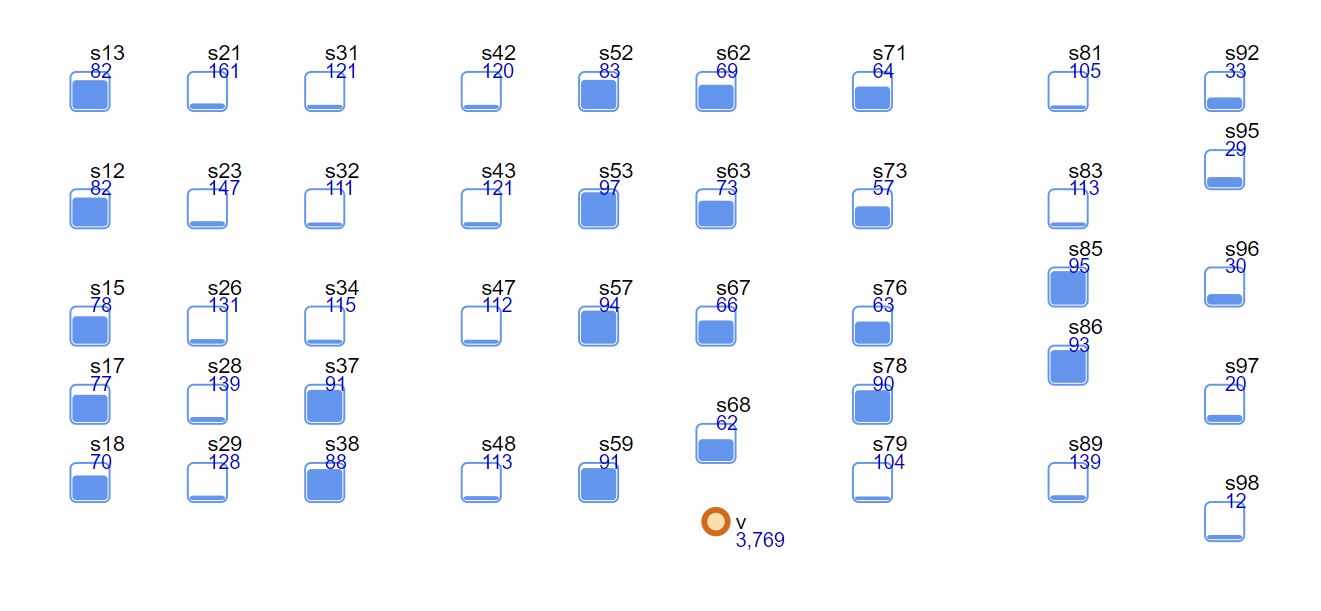
After optimization, an increase in passing cars by 346 is obtained, which increased throughput by 10%.
Abolghasemian et al. (2020) after adding accumulators at intersections to turn cars with their turn from the accumulator, the model was run and a traffic jam was created due to bad phases of the traffic lights. Rachih et al. (2022) the phases of traffic lights have changed only at p1 and p4 due to their transfer to another stop line of the intersection.
To optimize the phases of traffic lights after the modernization of the intersection, the method of maximizing the passing cars was used. The resulting traffic light phases are shown in Figure 8.
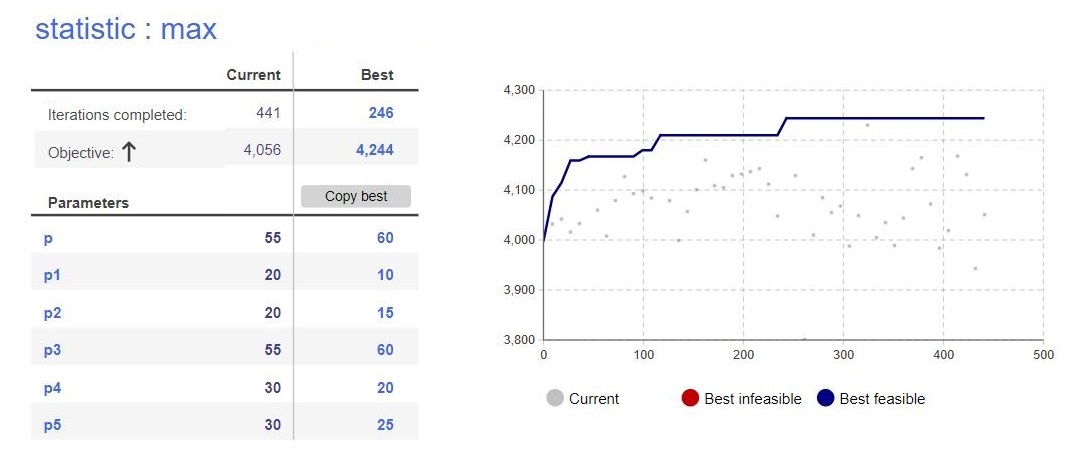
These parameters have been slightly changed to improve the capacity of the adjacent sides p1, p4 - 20, p2, p5-25, so that the main street and the side street are not blocked.
The results of the model with accumulators and new traffic light phases are shown in Figure 9.
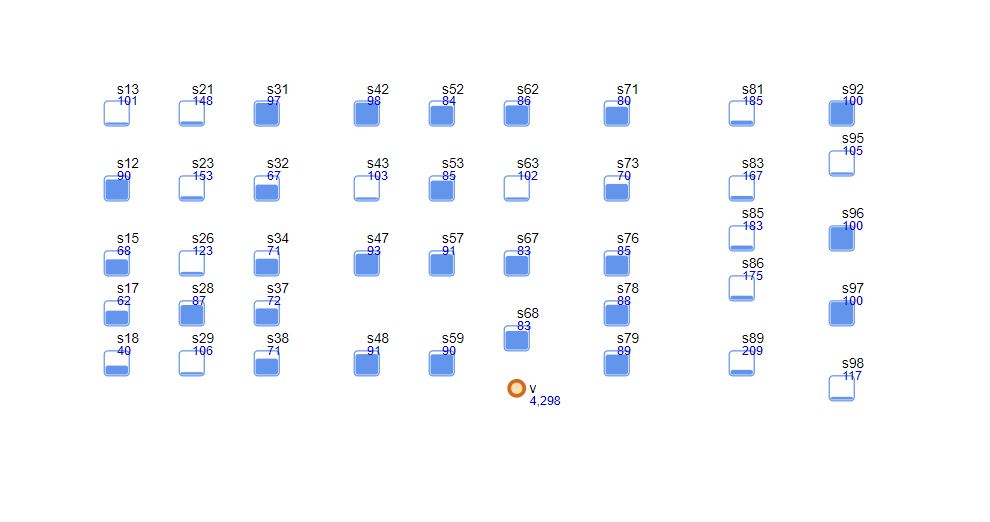
The following is the result of running the model for 2 hours to check for problems. The result is shown in Figure 10.
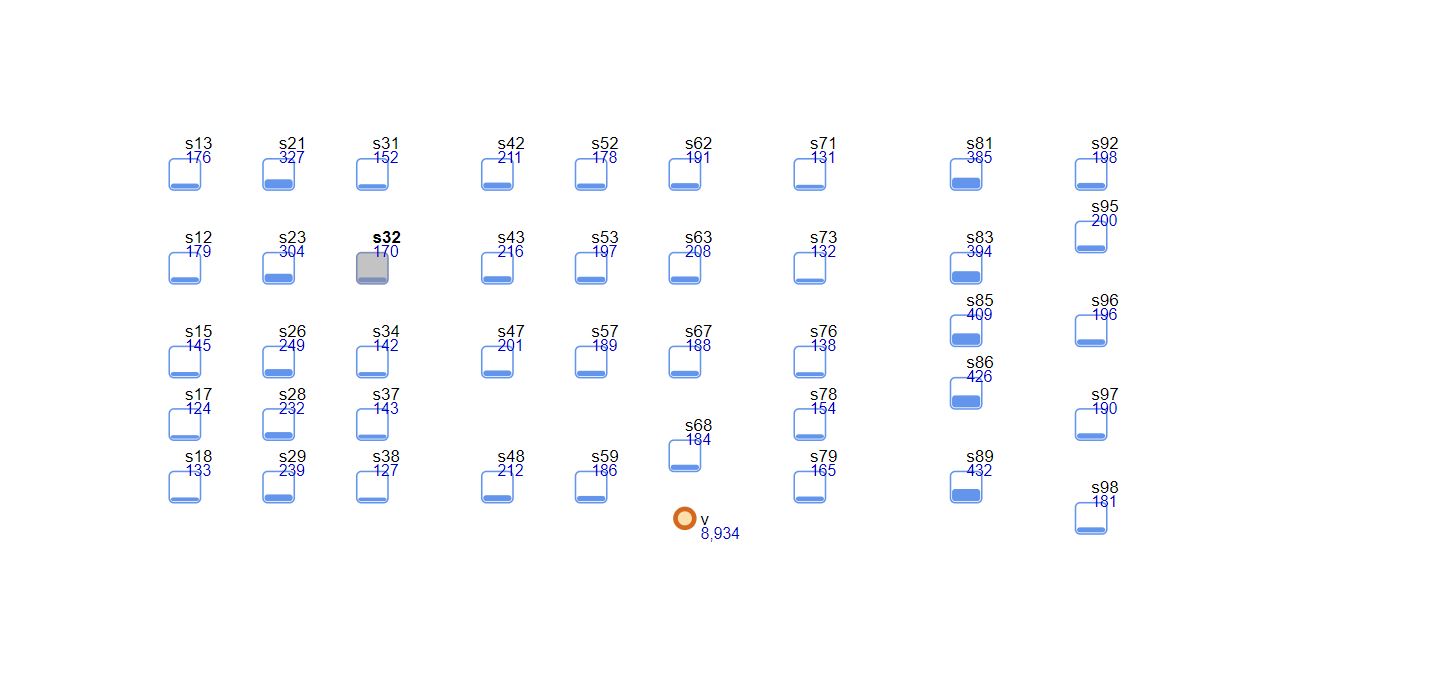
The model did not create a traffic jam after running the model for 2 hours. The Figures increased proportionally to 8934 vehicles.
Findings
Based on the results obtained from the models, the obtained throughput data is displayed in Table 1.
As the results show, in the model the main indicators of the transport route do not fall, but at the same time, the indicators on 7,8,9 roads improve. The introduction of waiting locks increases the throughput of the road. The main increase is about 125% per hour and about 130% in 2 hours.
Conclusion
After the study, it can be said that the modernization of T-type intersections and their optimization can increase the capacity of roads up to 30%.
The optimization method can be applied at various intersections and identify the best traffic light timings. If you study the statistics of the movement of cars between roads, you can present more accurate models.
The presented solution is economical and does not require large financial investments.
The implementation of this technique can reduce the number of traffic jams in the city during rush hours.
Acknowledgments
This work was supported by the Ministry of Science and Higher Education of the Russian Federation (Grant No.075-15-2022-1121).
References
Abolghasemian, M., Kanafi, A. G., & Daneshmandmehr, M. (2020). A two-phase simulation-based optimization of hauling system in open-pit mine. Iranian Journal of Management Studies (IJMS), 13(4), 705-732. DOI:
Aramesh, S., & Ghorbanian, A. (2020). Multi-objective Optimization for a Complex Intersection Using Design of Experiments and Simulation. Journal Européen des Systèmes Automatisés, 53(6), 791-802. DOI:
Chen, H. X., Huang, X. J., Li, H., & Zhang, H. B. (2021). Coordinated timing of multiple intersections based on Anylogic. Advances in Transportation Studies, 55, 283-290.
Chu, D., Wei, S., & Lin, Y. (2015). The application of pedestrian microscopic simulation technology in researching the influenced realm around urban rail transit station. Journal of Traffic and Transportation Engineering, 4, 242-246. DOI:
Ikidid, A., El Fazziki, A., & Sadgal, M. (2021). A Fuzzy Logic Supported Multi-Agent System For Urban Traffic And Priority Link Control. JUCS - Journal of Universal Computer Science, 27(10), 1026-1045. DOI:
Kuzmin, D., & Baginova, V. (2022). Discrete-Event Intersection Operation Model (Yasnyy Proyezd-Dezhnev street, Moscow). Smart Innovation, Systems and Technologies, 283-294. DOI:
Lu, K., Tian, X., Jiang, S., Xu, J., & Wang, Y. (2022). Optimization model for regional green wave coordinated control based on ring-and-barrier structure. Journal of Intelligent Transportation Systems, 26(1), 68-80. DOI:
Merkuryeva, G., & Bolshakovs, V. (2010). Vehicle Schedule Simulation with AnyLogic. 2010 12th International Conference on Computer Modelling and Simulation. DOI:
Pop, M. D. (2020). Decision making in road traffic coordination methods: a travel time reduction perspective. In 2020 International Conference Engineering Technologies and Computer Science (EnT) (pp. 42-46). IEEE. DOI:
Rachih, H., Mhada, F. Z., & Chiheb, R. (2022). Simulation optimization of an inventory control model for a reverse logistics system. Decision Science Letters, 11(1), 43-54. DOI:
Song, X. M., Zhang, Y. N., & Ma, L. (2020). An Optimization Model for Dynamic Lane Grouping and Signal Phase at Intersection. Journal of Transportation Systems Engineering and Information Technology, 20(6), 121.
Stupin, A., Kazakovtsev, L., & Stupina, A. (2022). Control of traffic congestion by improving the rings and optimizing the phase lengths of traffic lights with the help of anylogic. Transportation Research Procedia, 63, 1104-1113. DOI:
Sun, L., Tao, J., Li, C., Wang, S., & Tong, Z. (2018). Microscopic Simulation and Optimization of Signal Timing based on Multi-Agent: A Case Study of the Intersection in Tianjin. KSCE Journal of Civil Engineering, 22(9), 3373-3382. DOI:
Copyright information

This work is licensed under a Creative Commons Attribution-NonCommercial-NoDerivatives 4.0 International License
About this article
Publication Date
27 February 2023
Article Doi
eBook ISBN
978-1-80296-960-3
Publisher
European Publisher
Volume
1
Print ISBN (optional)
-
Edition Number
1st Edition
Pages
1-403
Subjects
Hybrid methods, modeling and optimization, complex systems, mathematical models, data mining, computational intelligence
Cite this article as:
Stupin, A., Ovchinnikova, I., Shagaeva, O., & Stasiuk, V. (2023). Optimization of Road Traffic on Karaulnaya Street in the City of Krasnoyarsk. In P. Stanimorovic, A. A. Stupina, E. Semenkin, & I. V. Kovalev (Eds.), Hybrid Methods of Modeling and Optimization in Complex Systems, vol 1. European Proceedings of Computers and Technology (pp. 61-70). European Publisher. https://doi.org/10.15405/epct.23021.8

